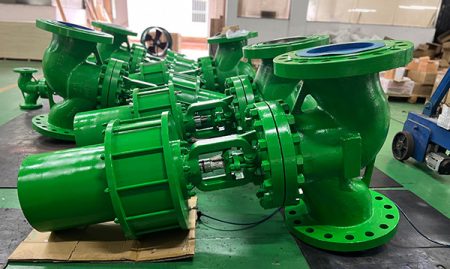
A modulating valve changes how much liquid or gas can pass through by moving its opening to any spot between fully open and fully closed. It does not just turn on or off like regular valves. A modulating valve gives very exact control. This is important for systems that need a steady flow or need to keep temperature, pressure, or levels just right. Many industries use these valves to make things safer, work better, and improve product quality in process control. For example, a pneumatic valve is often used in water treatment plants. A butterfly valve or electric valve helps control flow in big buildings and HVAC systems.
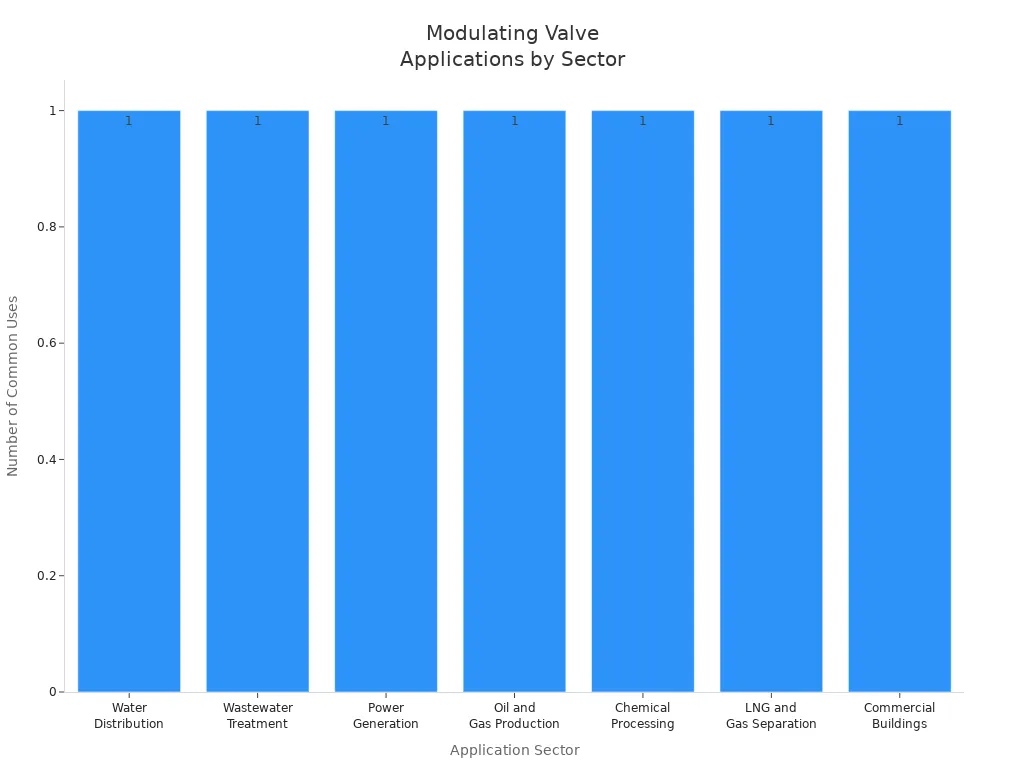
Modulating Valve Basics
Definition
A modulating valve can open or close to any position. It does not just stay fully open or closed. This helps control how much liquid or gas moves through a system. Experts say a modulating valve changes its opening all the time. This lets it control flow, pressure, or temperature very well. It uses actuators, positioners, and sensors to work. These parts help the valve follow control signals. The signals can be electrical or digital. This means the valve can change quickly when needed. Small changes keep systems steady and working well.
Core Function
A modulating control valve manages fluid flow very carefully. It uses actuators to move the valve to the right spot. The valve does not just open or close all the way. It gets signals from a control system. These signals tell the valve how much to open or close. Sensors give feedback to help the valve stay in the right place. This helps keep flow, pressure, or temperature at the right level. Good control is important for safety, saving energy, and making products better.
Note: Modulating valves stop sudden changes in flow or pressure. This helps protect equipment and keeps things safe.
Key Differences
Modulating valves and on-off valves control flow in different ways. On-off valves only open or close all the way. They are good for simple jobs, like stopping water fast. Modulating valves can stop anywhere between open and closed. This lets them control flow more exactly.
Here is a table that shows the key differences:
| Feature | On-Off Valves | Modulating Valves |
|---|---|---|
| Operation States | Two states: fully open or fully closed | Continuous adjustment between fully open and fully closed |
| Flow Control | Binary flow control (full flow or no flow) | Precise, variable flow control |
| Control Signals | Not required | Requires control signals (e.g., 4-20 mA electrical) |
| Complexity | Simple operation, easy to understand | Complex operation with feedback mechanisms |
| Cost | Generally less expensive to purchase and maintain | More expensive due to complexity and control systems |
| Response Time | Faster response due to simple open/close action | Slower response when making fine adjustments |
| Application Suitability | Suitable for basic on/off control applications | Suitable for processes requiring precise regulation |
| Industry Examples | Emergency shutdown, pipeline isolation | Power plants, chemical process control, HVAC systems |
- On-off valves work fast and cost less. But they cannot control flow very well.
- Modulating valves have more parts and cost more. But they give better control and help systems work better.
How Modulating Valves Work
Operating Principle
A modulating valve can open or close to any spot. It does not just stay all the way open or closed. The actuator gets signals from the control system. These signals can be air pressure or electricity. For example, a pneumatic actuator uses a 3-15 psi signal. An electric actuator uses a 0-10 VDC signal. The control system sends signals based on what is needed right now. The valve moves in small steps to open or close. This helps keep the flow rate very exact. Both rising stem and quarter-turn valves can do this job. The system uses flow meters to check the flow. This keeps the flow steady and correct.
Tip: Changing the flow slowly helps stop sudden jumps in pressure or temperature. This keeps equipment safe and working well.
Main Components
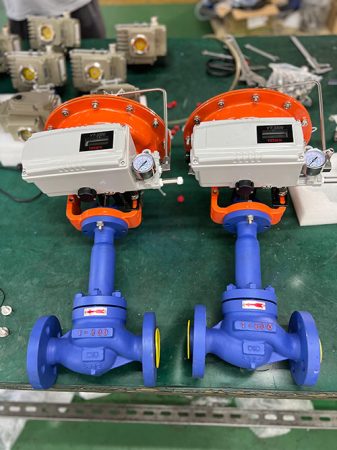
A modulating control valve has many important parts. Each part has a special job to do.
Actuator
The actuator is a device that moves the valve. It gets signals from the control system. Then it changes the valve’s position. Actuators can use air, electricity, or hydraulic fluid. Pneumatic actuators use air to move the valve. Electric actuators use voltage to make it move. Hydraulic actuators use fluid pressure to work. The actuator helps the valve move fast and correctly.
Positioner
The positioner makes sure the valve is in the right spot. It checks what the control system wants and what the valve is doing. If they do not match, the positioner fixes it. It moves the actuator until the valve is right. Positioners help keep control even if things change.
Valve Body
The valve body is the main part where fluid flows. It holds up to pressure and guides the liquid or gas. The body has the trim inside it. The trim has the stem, plug, and seat. These parts work together to control the flow.
Sensors
Sensors give real-time updates to the control system. They measure things like flow, pressure, or temperature. The control system uses this information to move the valve. Sensors help keep things steady and working well by sending updates right away.
Note: Sensor feedback lets the system react fast to changes. This keeps flow rates correct and steady.
Control Mechanisms
Modulating control valves use smart systems to control flow. The control system watches things like flow, pressure, or temperature. If something changes, it sends a signal to the actuator. The actuator moves the valve stem to change the opening. Positioners turn signals into exact valve moves. Feedback checks if the valve is in the right spot. If not, the actuator makes small changes. This loop keeps things from going too high or low and keeps everything steady.
Key steps in the control process:
- The control system sends a signal to the actuator using real-time data.
- The actuator moves the valve to the right spot.
- Sensors check the flow or pressure.
- Feedback compares real numbers to the target.
- The system keeps making small changes to stay exact.
| Component | Function |
|---|---|
| Actuator | Moves the valve when it gets control signals |
| Positioner | Makes sure the valve is in the right spot |
| Valve Body | Guides fluid and holds up to pressure |
| Sensors | Give feedback for good control |
A modulating valve works best when steady flow is needed. Using actuators, positioners, sensors, and feedback helps the valve adjust all the time. This keeps products good, people safe, and systems running well in many industries.
Modulating Valve Types
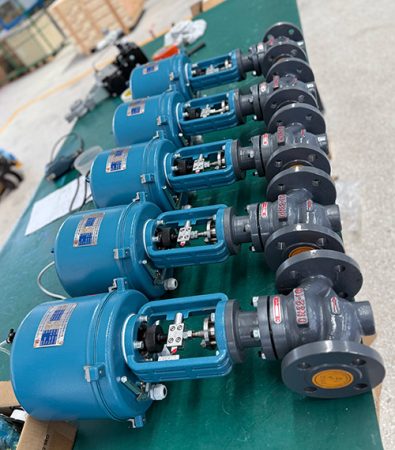
Globe
Globe valves are good at controlling flow very exactly. They have a disc-shaped plug that moves up and down. This up and down movement lets the valve open or close slowly. The design helps people set the flow rate just right. Globe valves work well in systems that need steady control. HVAC systems often use globe valves. Engineers pick globe valves for hot water, steam, and chiller systems. These valves can handle high pressure and control flow without much damage.
Note: Globe valves are used where small flow changes matter a lot, like in labs or factory process control.
A globe valve is easy to fix. The seat and plug are simple to reach. Technicians can repair or change parts without taking out the whole valve. This saves time and keeps busy places running.
Ball
Ball valves have a round ball with a hole in it. When the ball turns, the hole lines up with the pipe. This lets fluid move through. Turning the ball 90 degrees shuts the valve fast. Ball valves are quick and simple. They work well when you need to stop flow quickly. Emergency water lines and gas systems use ball valves. HVAC systems use ball valves for chilled or hot water. These valves do not slow down the flow much.
Some ball valves have special discs or seats. These help the valve control flow better. Engineers use these ball valves when they need fast and accurate control. For example, a ball valve with a special disc can change flow smoothly.
- Ball valves give:
- Fast open and close with a quarter turn
- Low flow resistance
- Good sealing, even after many uses
Butterfly
Butterfly valves have a flat, round disc on a rod. When you turn the rod, the disc spins to open or close the valve. This turning only needs a quarter turn. Butterfly valves are quick and easy to use. Their thin shape fits well in big pipes with little space. Water plants and big HVAC systems use butterfly valves. They can handle lots of flow with little pressure drop.
Butterfly valves can control flow, but work best mostly open or closed. They are light and easy to put in and fix. People use them for water, air, or other fluids in pipes.
Here is a table that shows the main modulating valve types:
| Valve Type | Construction | Motion Type | Typical Application |
|---|---|---|---|
| Globe | Disc on a rising stem | Linear (multi-turn) | Precise flow control, HVAC, steam, process |
| Ball | Spherical ball with a hole | Rotary (quarter-turn) | Quick shut-off, HVAC, water, gas |
| Butterfly | Rotating flat disc | Rotary (quarter-turn) | Large pipelines, water treatment, HVAC |
Tip: Pick the right valve type by thinking about speed, control, and space.
Specialized Types
Specialized modulating valves fix special flow problems. Engineers use these when regular globe, ball, or butterfly valves do not work. Each type has features that help in certain jobs.
Common Specialized Modulating Valves:
- V-Port Ball Valves:
These have a ball with a V-shaped notch. The notch helps control flow better. V-port ball valves are used for fluids that need careful control. They are common in chemical plants and food factories. - Segmented Ball Valves:
These have a ball with a piece cut out. This shape gives better control of flow rates. Segmented ball valves work with thick liquids or fluids with bits in them. They do not clog or wear out fast. - Pinch Valves:
Pinch valves have a soft tube inside. The actuator squeezes the tube to change flow. These work best with slurries, powders, or liquids with solids. Pinch valves do not have metal touching the fluid. - Diaphragm Valves:
Diaphragm valves use a soft diaphragm to open or close the flow. The actuator pushes the diaphragm down to stop flow. These valves are good for acids, clean water, or harsh fluids. Diaphragm valves keep the fluid away from moving parts. - Needle Valves:
Needle valves have a long, thin point that fits into a seat. Turning the handle moves the needle in or out. This lets you control flow very carefully. Needle valves are used in labs and small systems.
Tip: Specialized modulating valves help control tricky fluids. They make things safer and more reliable in hard places.
Comparison Table of Specialized Modulating Valves
| Valve Type | Key Feature | Best Use Case | Fluid Type |
|---|---|---|---|
| V-Port Ball | V-shaped notch for control | Chemical dosing | Liquids, gases |
| Segmented Ball | Segment cut for flow | Slurry handling | Thick liquids |
| Pinch | Flexible tube, no metal | Powder or slurry transport | Slurries, powders |
| Diaphragm | Flexible diaphragm | Corrosive fluid control | Acids, clean water |
| Needle | Tapered needle for fine flow | Lab experiments | Low flow liquids |
Engineers pick specialized modulating valves for tough jobs. For example, a pinch valve works well in mining where fluid has rocks or sand. A diaphragm valve stops leaks when moving dangerous chemicals. Needle valves help scientists measure tiny liquid amounts in labs.
Specialized types cost more than regular valves. They last longer and need less fixing in rough places. Picking the right valve keeps systems safe and working well.
Note: Always choose the valve for the fluid and job. Specialized valves can really help system performance.
Pressure Testing Standards for Modulating Valves
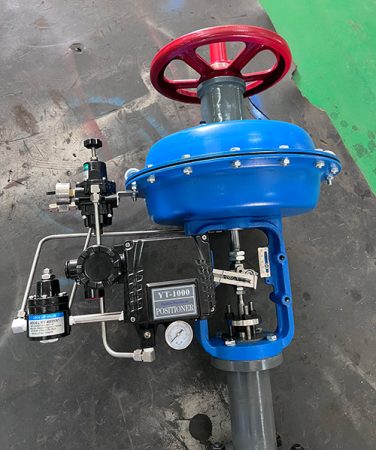
Purpose of Pressure Testing
Pressure testing is very important for modulating valves. It helps make sure the valves are safe and work well. Engineers use these tests to see if valves can handle real system pressures. Testing finds leaks or weak spots before valves are used. This keeps people and equipment safe.
- Pressure testing uses set pressures to find leaks or breaks. This stops dangerous leaks or sudden valve failures.
- Engineers can spot problems early and check if valves stay strong. This makes the whole system more reliable.
- Good testing needs the right tools and strict rules. This helps meet industry standards.
- Testing also finds wear or damage early. Maintenance teams can fix or swap valves before big problems happen.
- Safety steps, like wearing gear and checking for risks, protect workers during high-pressure tests.
Pressure testing keeps people, equipment, and nature safe. It helps companies follow safety rules and keep systems working well.
Ensuring valve integrity and safety
Engineers use pressure testing to make sure valves stay strong. This stops breaks and keeps systems safe.
Verifying leak-tightness and performance under pressure
Testing checks if valves seal tight and work well under pressure. This stops leaks and keeps fluids inside.
Meeting regulatory and industry requirements
Companies must follow rules from industry groups. Pressure testing proves valves meet these rules and can be used in important places.
American Standards (ANSI/ASME)
Overview of ANSI/ASME pressure testing standards
American standards give clear rules for valve testing. Groups like ANSI and ASME make these rules for engineers and makers. These rules help keep valves safe in many jobs.
Common standards: ASME B16.34, API 598
Valve design and testing in the U.S. must follow rules like ASME B16.34 and API 598. ASME B16.34 covers pressure ratings and what materials to use. API 598 sets rules for closure tests and leak checks. Some valves need extra tests, like fire checks or special gas tests. These rules help engineers pick and test the right valve for real use.
| Standard | Scope / Application | Key Requirements for Modulating Valves and Pressure Testing |
|---|---|---|
| ASME B16.34 | Pressure-temperature ratings and material selection for valves | Defines pressure-temperature classes; provides rating tables to determine valve class based on material and service conditions. |
| API 598 | Valve testing requirements | Requires closure tests and leak-tightness verification; includes special high-pressure closure test for double block-and-bleed capability. |
| API 607 | Fire testing for valves with nonmetallic seats | Provides type test to confirm fire resistance; valves passing are marked as Fire Tested. |
American standards help engineers make sure valves are safe and ready for hard jobs.
Test types: hydrostatic, pneumatic, and seat leakage tests
Engineers use three main tests. Hydrostatic tests use water to check for leaks and strength. Pneumatic tests use air or gas to find small leaks. Seat leakage tests make sure the valve closes tight under pressure.
International Standards (ISO)
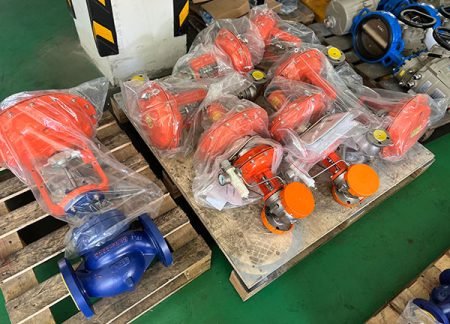
Key ISO standards: ISO 5208 (pressure testing of metallic valves)
ISO standards guide valve testing all over the world. ISO 5208 sets rules for how much a valve can leak and what pressures to use. Other ISO rules cover fire safety, pipelines, and special valve types.
| ISO Standard | Key Focus Area | Core Requirements / Test Methods | Application / Industry Impact |
|---|---|---|---|
| ISO 5208 | Industrial valve leakage rate testing | Defines leakage levels (Rate A to G), test pressures (low and high), strict sealing and pressure requirements | Required by EU PED Directive and China TSG; used in chemical reactors, nuclear power valves |
| ISO 14313 | Pipeline valve design and testing | Full-bore design, fire safety, low temperature impact test, pressure ratings | Used in major pipelines; ensures valves fit and function globally |
| ISO 10497 | Fire testing of valves | Flame exposure, cooling, leakage limits | Emergency shut-off valves in refineries, offshore wellhead control valves |
Test procedures: hydrostatic shell test, seat leakage test
ISO rules need hydrostatic shell tests to check valve strength. Seat leakage tests make sure the valve seals tight. These tests help valves meet tough safety and performance rules.
Benefits: global consistency and acceptance
ISO rules make sure valves from different countries work the same way. This helps companies buy and use valves worldwide without worry. Same testing lowers failures and keeps systems safe.
ISO standards help keep people safe, make systems reliable, and support easy trade everywhere.
German Standards (DIN)
Relevant DIN standards: DIN EN 12266-1, DIN EN 12266-2
German DIN standards set strict rules for pressure testing modulating valves. DIN EN 12266-1 and DIN EN 12266-2 guide how engineers test valves for leaks and strength. These standards help make sure valves work safely in many industries. DIN standards also cover valve size, shape, and how parts fit together. Engineers use these rules to check if valves can handle high pressure and tough conditions.
The table below shows important aspects of German DIN standards for modulating valves:
| Aspect | Details |
|---|---|
| Main DIN Standards | DIN EN 558-1, DIN 28140-1, DIN 2501, ISO 5752 series 1, ISO 7005-2 |
| Design Standards | DIN/ISO, ANSI/ISA-75.08.01 |
| Nominal Pressure | Up to 16 bar (Class 150) |
| Flange Standards | ISO 7005-2 type B, ASME B16.5 class 150 (raised face) |
| Temperature Range | -60 °C to +180 °C (-75 °F to +360 °F) |
| Certifications | EU Pressure Equipment Directive 2014/68/EU, German Clean Air Act (TA-Luft), DIN EN ISO 15848-1, SIL |
| Safety Features | Thick-walled PFA lining, heavy-duty bellows, hermetically tight bellows, replaceable seat and plug, overpressure protection |
| Reliability Emphasis | Leakage control, functional safety, long service life diaphragms, clean-room suitability |
DIN EN 12266-1 focuses on how to test for leaks and strength. DIN EN 12266-2 explains extra tests and special cases. These standards help engineers find problems before valves go into service.
Focus on test methods and acceptance criteria
DIN standards use clear test methods. Engineers fill the valve with water or air and raise the pressure. They look for leaks and check if the valve holds strong. DIN EN 12266-1 sets rules for how much a valve can leak. If a valve leaks too much, it does not pass. DIN EN 12266-2 covers extra tests, like checking how the valve works after many cycles.
Acceptance criteria tell engineers what is safe. The valve must not leak more than the allowed amount. It must stay strong under pressure. If the valve passes all tests, it meets DIN standards and can be used in important jobs.
Tip: Engineers always check acceptance criteria before using a valve. This keeps systems safe and reliable.
Emphasis on safety and reliability
German standards put safety first. Valves must have thick walls and strong bellows to stop leaks. Many valves use special linings to resist chemicals. Some designs use replaceable seats and plugs for easy repair. DIN standards also require valves to meet strict environmental rules, like the German Clean Air Act.
Reliability matters in every test. Engineers look for long-lasting parts, like strong diaphragms. Valves must work well in clean rooms and tough places. DIN standards help companies trust that their valves will last and protect people and the environment.
Typical Pressure Test Procedures
Hydrostatic testing: using water to check for leaks and strength

Hydrostatic testing uses water to fill the valve. Engineers raise the pressure to a set level. They watch for leaks and see if the valve holds strong. Water makes it easy to spot leaks. If the valve stays dry and does not break, it passes the test.
Steps in hydrostatic testing:
- Fill the valve with water.
- Increase the pressure to the test level.
- Watch for leaks or drops in pressure.
- Check if the valve stays strong.
Hydrostatic tests help find weak spots before the valve goes into service.
Pneumatic testing: using air or gas for leak detection
Pneumatic testing uses air or gas instead of water. Engineers fill the valve with air and raise the pressure. They listen for hissing sounds or use soap to find bubbles. Pneumatic tests can find very small leaks that water might miss.
Steps in pneumatic testing:
- Fill the valve with air or gas.
- Raise the pressure.
- Look and listen for leaks.
Note: Pneumatic tests need extra safety steps because air can escape quickly.
Seat leakage testing: ensuring tight shutoff under pressure
Seat leakage testing checks if the valve closes tightly. Engineers close the valve and apply pressure. They measure if any fluid gets past the seat. The valve must hold tight and not let fluid through. This test makes sure the valve can stop flow when needed.
Seat leakage tests help keep systems safe. If a valve leaks at the seat, it cannot protect equipment or people.
Tip: Regular seat leakage tests help find problems early and keep valves working well.
Control Valve Design Standards
Design standards are very important for control valves. They help keep valves safe and reliable. These rules help engineers pick the right valve for each job. Standards also make sure valves from different companies fit together. They cover things like valve size, pressure limits, materials, and how valves connect to pipes. Workers need training and regular checks to use control valves safely. This helps stop mistakes. Groups like ASME, API, ISO, and DIN make these rules. Their standards help systems run safely and smoothly.
American Standards (ANSI/ASME)
Overview of ANSI and ASME standards relevant to control valve design
In the U.S., ANSI and ASME set the main rules for control valves. These rules say how valves should be made, tested, and labeled. They help engineers know a valve will work well and last long. The standards also make sure valves fit with other system parts.
Common standards: ANSI/ISA-75, ASME B16.34
Some important standards are ANSI/ISA-75 and ASME B16.34. ANSI/ISA-75 tells how to test control valves and measure flow. ASME B16.34 gives rules for valve design, wall thickness, and flange sizes. These standards help engineers choose the right valve for each job.
| Standard | Description |
|---|---|
| ASME B16.34 | Design and construction of valves, including wall thickness and dimensions |
| ANSI/ISA-75 | Testing, flow equations, and performance for control valves |
| ASME B16.10 | Face-to-face and end-to-end dimensions for valves |
Key requirements: pressure ratings, material specifications, testing procedures
American standards focus on three main things:
- Pressure ratings: How much pressure a valve can handle.
- Material specifications: What materials make the valve strong and safe.
- Testing procedures: How to check the valve for leaks and strength.
These rules help engineers pick valves that will not break in hard jobs.
German Standards (DIN)
Introduction to DIN standards for control valves
Germany uses DIN standards for control valves. These rules help keep valves safe and easy to use. DIN standards say how valves are built and how they connect to other parts.
Typical standards: DIN EN 1349, DIN 3356
DIN EN 1349 and DIN 3356 are two main standards. DIN EN 1349 covers control valve needs for factories. DIN 3356 gives rules for globe and angle valves. Both help engineers pick the right valve for each system.
Focus areas: valve dimensions, performance criteria, marking
DIN standards focus on:
- Valve dimensions: Making sure valves fit with pipes and equipment.
- Performance criteria: Setting rules for how well valves must work.
- Marking: Requiring clear labels for easy identification.
These rules help workers install and fix control valves with fewer mistakes.
British Standards (BS)
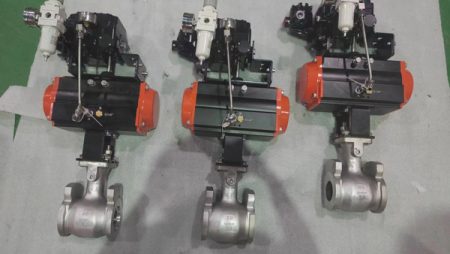
Overview of BS standards applied to control valves
British Standards, called BS, guide control valve design in the UK and other places. These rules help keep systems safe and make sure valves from different makers fit together.
Notable standards: BS 5793, BS EN 60534
BS 5793 and BS EN 60534 are key standards. BS EN 60534 covers how control valves should work and be tested. BS 5793 gives rules for valve size and connections.
Emphasis on safety, compatibility, and quality assurance
BS standards focus on:
- Safety: Making sure each valve works safely in all conditions.
- Compatibility: Ensuring valves fit with other system parts.
- Quality assurance: Setting rules for testing and checking each valve before use.
Following these standards helps engineers and workers trust that each control valve will work well in any job.
International Standards (ISO)
Role of ISO standards in harmonizing global valve design
ISO standards help companies make control valves that work together. These rules tell engineers how to design, test, and measure valves. If engineers use ISO standards, valves from different countries will fit together. This helps factories and buildings use parts from anywhere. ISO standards also keep people safe. They make sure every control valve meets strict safety rules.
ISO standards give everyone the same way to talk about control valve design. This helps stop mistakes and makes fixing valves easier.
Key standards: ISO 9001 (quality management), ISO 5208 (pressure testing), ISO 5752 (face-to-face dimensions)
Some ISO standards are very important for control valves. ISO 9001 is about quality management. It tells companies how to make control valves the right way every time. ISO 5208 is for pressure testing. This rule explains how to test a control valve so it does not leak and can handle high pressure. ISO 5752 sets the size between valve faces. This means valves from different places will be the same size. These standards help engineers pick the right control valve for any job.
Here is a table that shows what each ISO standard does:
| ISO Standard | What It Covers | Why It Matters |
|---|---|---|
| ISO 9001 | Quality management | Makes sure every control valve works well |
| ISO 5208 | Pressure testing | Checks for leaks and strength |
| ISO 5752 | Face-to-face dimensions | Helps valves fit in any system |
Benefits: global compatibility, consistent quality, simplified procurement
Using ISO standards gives many good things. Global compatibility means valves from different companies fit together. Consistent quality means every control valve works the same way. Simplified procurement makes buying and replacing valves easier and faster. Engineers know ISO-certified control valves will do the job.
- Global compatibility: Valves fit and work everywhere ??
- Consistent quality: Every control valve meets high standards
- Simplified procurement: Buying valves is quick and easy
When engineers and companies use ISO standards, they save time and money. They also help keep systems safe and working well.
Flow Characteristics of Modulating Valves
Flow characteristics explain how flow changes as a modulating valve opens or closes. These details help engineers know what to expect from a valve in a system. Picking the right flow characteristic is important for good control and saving energy. If the wrong type is picked, the system might waste energy or not keep things steady.
- Flow characteristics show how valve position affects flow rate.
- The main types are equal percentage, linear, and quick opening.
- Picking the right one helps keep things safe, comfortable, and efficient.
- Valve sizing and flow coefficient (Cv) also change how well the valve works.
Equal Percentage Characteristic
Definition
An equal percentage valve starts with slow flow. As it opens more, the flow increases faster. Each small move lets through a bigger percent of flow than before. This means flow goes up slowly at first, then much faster when the valve is open more.
Advantages and Typical Applications
Equal percentage valves give smooth control when almost closed. They work well in systems where the load changes a lot, like heating or cooling coils. These valves help keep temperatures steady even if the system demand changes.
- Gives smooth control at low openings.
- Handles big changes in system load.
- Stops sudden jumps in flow.
Typical applications include:
- HVAC systems with changing heating or cooling needs.
- Process control in chemical plants.
- Power plants where loads change often.
Linear Characteristic
Definition
A linear valve lets flow increase at a steady rate as it opens. If the valve is halfway open, it lets through half the flow. The flow changes in direct steps with the valve position.
Advantages and Typical Applications
Linear valves make it easy to guess how much flow will change with each move. They are good for systems where the load stays steady or changes slowly. These valves help keep control simple and easy to manage.
- Gives steady, predictable flow changes.
- Works well in systems with steady loads.
- Makes tuning the system easier.
Typical applications include:
- General flow control jobs.
- Water treatment plants.
- Systems with steady heat output.
Quick Opening Characteristic
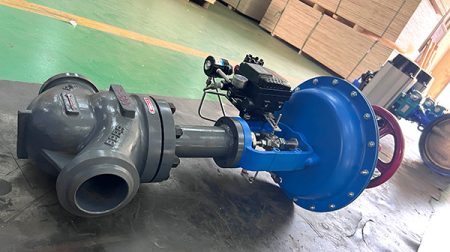
Definition
A quick opening valve lets a lot of flow through with a small move from closed. Most of the flow happens right at the start. The increase slows down as the valve opens more.
Advantages and Typical Applications
Quick opening valves are best when fast flow is needed right away. They work well for on-off jobs or emergency shutoff. These valves do not give fine control but act fast.
- Gives fast flow increase at low openings.
- Good for safety or emergency systems.
- Simple to use.
Typical applications include:
- Emergency shutdown systems.
- Filling tanks quickly.
- On-off control in pipelines.
| Flow Characteristic | Main Advantage | Typical Use Case |
|---|---|---|
| Equal Percentage | Fine control at low openings | HVAC, chemical processing, power plants |
| Linear | Predictable, steady flow changes | Water treatment, general flow control |
| Quick Opening | Rapid flow increase for fast response | Emergency shutoff, tank filling |
Tip: Always pick the flow characteristic that matches the system’s needs for best results and efficiency.
Actuator Types for Control Valves
Actuators are very important for control valves. They take control signals and make the valve move. This lets the valve change flow and pressure very exactly. Actuators help systems work by themselves and cut down on mistakes. They also let people control things from far away. Actuators keep things safe by acting fast when changes happen. They can help shut down a system in an emergency. There are different actuator types for different jobs. Some are better for speed, some for power, and some for safety in hard places.
Diaphragm Actuators
Operating Principle
A diaphragm actuator uses air to push a soft part called a diaphragm. When air goes in, it pushes the diaphragm against a spring. This makes the valve stem move up or down. Moving the stem changes how open the valve is. Diaphragm actuators work best with low air pressure, like 3 to 15 psi.
Advantages and Limitations
Diaphragm actuators have many good points:
- They are very sensitive and give fine control.
- The design is simple and has few parts, so fixing is easy.
- They have a spring that closes the valve if air is lost.
- They do not cost much to make or fix.
But there are some problems too:
- The diaphragm cannot move very far, so the stroke is short.
- They do not work well with very high air pressure.
- The diaphragm can wear out if it gets too hot, cold, or meets strong chemicals.
| Aspect | Diaphragm Actuator |
|---|---|
| Construction | Flexible membrane, compact, fewer parts |
| Air Pressure Range | Low (3–15 psi) |
| Stroke Length | Limited |
| Best For | Precise, low-pressure control |
Common Applications
You will see diaphragm actuators in:
- Control valves in factories and plants
- HVAC and boiler systems in buildings
- Jobs that need low or medium pressure control
- Places where small, careful changes are needed, like chemical dosing
Tip: Use diaphragm actuators when you need soft, careful moves.
Piston Actuators
Operating Principle
A piston actuator uses air to push a solid piston inside a tube. When air goes in, it moves the piston in a straight line. This pushes or pulls the valve stem to change the valve’s position. Piston actuators can use much higher air pressure than diaphragm types, sometimes up to 150 psi or more.
Advantages and Limitations

Piston actuators have these good points:
- They give a lot of force for big or heavy valves.
- They can move the valve stem a long way.
- They work well in hard or rough places.
- They can be made to move both ways or return with a spring.
But they also have some downsides:
- They have more moving parts and seals, so they may need more fixing.
- They are bigger and heavier than diaphragm actuators.
- They cost more at first.
| Aspect | Piston Actuator |
|---|---|
| Construction | Solid piston in cylinder, larger housing |
| Air Pressure Range | High (up to 150 psi or more) |
| Stroke Length | Long |
| Best For | Large valves, high-pressure service |
Common Applications
Piston actuators are used in:
- Big control valves, like butterfly or ball valves
- High-pressure steam or gas systems
- Oil and gas pipes
- Jobs that need long movement or strong push
Note: Pick piston actuators for hard jobs that need power and long travel.
Control Valve Accessories
Control valve accessories help the system work better and safer. These extra parts make sure valves move fast and stay correct. They also help if something breaks or stops working. Each accessory has a special job to help the main valve and the whole system.
Positioners
Function and Importance
A positioner helps the modulating control valve move to the right spot. It gets a signal from the control system and checks where the valve is. The positioner compares the real spot to the wanted spot. If the valve is not right, it tells the actuator to move it. This keeps the valve quick and correct. Positioners help when the valve sticks or pressure changes. They make sure the valve always does what the control system says. Without a positioner, the valve might not move right, which can cause trouble.
Types of Positioners
There are different kinds of positioners. Pneumatic positioners use air signals to move the valve. Electric positioners use electric signals. Some can use both air and electric signals. Smart or digital positioners have microchips for better control and feedback. These digital types can talk to the control system and send data about the valve. Picking the right positioner depends on the actuator and what the system needs.
Tip: A good positioner helps the valve be more exact and saves energy.
| Accessory | Function Description |
|---|---|
| Positioner | Puts the valve in the right spot by using signals from the controller and giving feedback to the actuator. Makes sure the valve moves fast and stays correct by checking its position and changing it if needed. Connects electric signals to air-powered actuators. Can make big actuators move better. |
Handwheels
Manual Override
A handwheel lets people move the valve by hand. If power or air stops, the handwheel can open or close the valve. This is important in emergencies. The handwheel can put the valve in a safe spot if the automatic parts do not work. It works against the spring in the actuator, so the valve can be set as needed.
Typical Applications
Handwheels are used where safety is very important. In power plants or chemical factories, workers may need to move a valve fast if the system fails. Handwheels also help during repairs. Workers can test or set the valve without using the main system.
| Accessory | Function Description |
|---|---|
| Handwheel (Manual Override) | Lets people move the valve by hand if power or air is lost. It is a backup tool to open or close the valve, even with a spring return. |
Solenoid Valves
Role in Control Systems
A solenoid valve acts like a switch for air or fluid in the actuator. The control system sends an electric signal to the solenoid valve. The solenoid opens or closes to let air move or stop. This can move the main valve fast to a safe spot. Solenoid valves help the system react quickly in emergencies or when a fast change is needed.
Integration with Modulating Valves

Solenoid valves work well with modulating control valves. They can move the valve to a safe spot if something goes wrong. For example, if power fails, the solenoid valve can let air out and let the actuator spring move the valve. This keeps people and equipment safe.
| Accessory | Function Description |
|---|---|
| Solenoid Valve | An electric on-off or three-way valve that controls air in the actuator. It can move the control valve to a safe spot by letting air in or out, based on electric signals. Used for emergency or fail-safe actions. |
Note: Control valve accessories help the whole system work better and make it easier to use.
Amplifiers
Purpose in Valve Operation
Amplifiers make control signals stronger for modulating valves. Sometimes, the signal is too weak to move the valve or actuator. An amplifier takes the weak signal and makes it strong enough. This helps the valve move quickly and correctly. When the control system sends a small signal, the amplifier boosts it. The actuator then gets enough power to move the valve. This keeps flow, pressure, or temperature at the right level. Amplifiers also help when fast changes are needed. They make sure the valve moves right away.
Tip: Amplifiers help keep the system safe and steady by making valves react fast to control signals.
Common Types
There are different amplifier types for modulating valves. Each type works best in certain jobs.
- Pneumatic Amplifiers
These use air pressure to make signals stronger. They take a small air signal and turn it into a bigger one. Pneumatic amplifiers work well with air-powered actuators. They help the valve move faster and with more force. - Electro-Pneumatic Amplifiers
These change an electric signal into a strong air signal. The control system sends an electric signal to the amplifier. The amplifier then makes a bigger air signal for the actuator. This type is common in modern plants with electric control systems. - Hydraulic Amplifiers
Hydraulic amplifiers use fluid pressure to boost signals. They take a small hydraulic signal and make it strong enough to move big or heavy valves. These amplifiers are used where valves must handle high pressure or heavy loads. - Electronic Amplifiers
Electronic amplifiers make weak electric signals stronger. They are used when the actuator is powered by electricity. These amplifiers help the valve move smoothly and quickly.
| Amplifier Type | How It Works | Best Use Case |
|---|---|---|
| Pneumatic | Makes air signals stronger | Air-powered actuators |
| Electro-Pneumatic | Changes electric to strong air signal | Electric control systems |
| Hydraulic | Makes fluid signals stronger | Heavy-duty, high-pressure valves |
| Electronic | Makes electric signals stronger | Electric actuators |
Each amplifier type helps the control system work better. They make sure the valve gets the right signal strength every time. This keeps the process safe and running smoothly.
Note: Pick the amplifier that matches the actuator and what the control system needs.
Control Valve Applications
HVAC
HVAC systems use modulating valves to change how much heating or cooling fluid moves. These valves help rooms stay comfortable by making small changes to water or air flow. If a room gets too hot or cold, the control system tells the valve what to do. The valve opens or closes a little to fix the temperature. This happens all the time, so the system can react fast.
A pressure-independent control valve is used in many new HVAC systems. It keeps the flow steady even if the pressure changes. This saves energy and keeps the building comfortable. Big buildings use these valves for chilled water, hot water, or air flow. The valves work with actuators that let people control them from far away or set them to run on their own.
Tip: Modulating valves in HVAC systems help save energy and lower bills.
Industrial Processes
Factories and plants use modulating valves in many jobs. These valves control how much liquid, gas, or steam moves in mixing, heating, or cooling. In a chemical plant, a modulating feedwater valve adds water to a boiler at the right speed. This keeps steam pressure safe and steady. In food factories, valves help mix things by letting in the right amount of each fluid.
A pressure-independent control valve keeps flow steady, even if other parts change. This makes the process safer and more reliable. Many industries use actuators with these valves for remote or automatic control. Workers can adjust the system from a control room. This helps the plant run smoothly and follow safety rules.
- Main benefits in factories:
- Exact flow control for better products
- Safer systems by stopping sudden changes
- Less damage to equipment because valves move smoothly
Water Systems
Water plants and city water systems use modulating valves to keep water safe and clean. These valves change how much water or chemicals move during treatment. For example, a valve might add chlorine to water at a steady speed. This keeps the water safe to drink. In wastewater plants, valves control how much water goes through each cleaning step.
Actuators help these valves work by themselves. They open or close the valve using real-time data from sensors. This helps the plant use the right amount of chemicals and saves money. Water systems also use these valves to keep pipe pressure steady. This stops leaks and keeps water moving to homes and businesses.
| Application Area | Main Role of Modulating Valves | Typical Benefit |
|---|---|---|
| HVAC | Control heating/cooling fluid flow | Comfort, energy efficiency |
| Industrial Processes | Regulate process fluids and steam | Product quality, safety |
| Water Systems | Adjust water/chemical dosing and pressure | Clean water, system stability |
Note: Modulating valves help water systems meet safety rules and protect health.
Oil and Gas
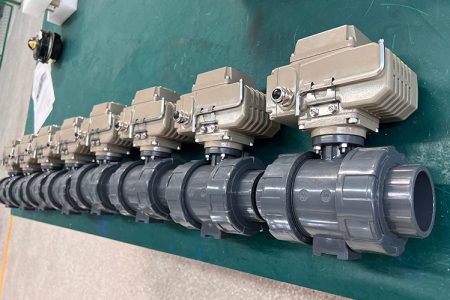
Oil and gas companies use modulating valves to keep things safe. These valves control how oil and gas move in pipes and plants. Workers change pressure and flow with these valves in real time. This stops leaks and keeps machines from breaking.
Engineers put modulating valves in important spots at refineries. The valves control steam, water, and chemicals during oil processing. For example, a modulating feedwater valve controls water going into a boiler. This keeps steam pressure steady and protects the system. In gas plants, modulating valves help mix gases and control heat. They also separate products by changing flow rates.
Oil rigs use modulating valves to make drilling safer. These valves can shut off flow fast if pressure gets too high. Workers send signals to the valves using control systems. The valves open or close as needed. This helps stop accidents and keeps people safe.
Tip: Modulating valves in oil and gas save energy and cut waste. They also help companies follow safety rules.
Here is a table that shows how modulating valves are used in oil and gas:
| Application Area | Role of Modulating Valve | Benefit |
|---|---|---|
| Refineries | Control steam and water flow | Stable pressure, safe operation |
| Pipelines | Adjust oil and gas flow | Prevent leaks, save energy |
| Gas Processing Plants | Mix and separate gases | Product quality, system control |
| Drilling Rigs | Manage drilling fluids | Safety, quick response |
Other Uses
Modulating valves are used in many places besides factories. Farmers use these valves in irrigation systems. The valves control how much water goes to each field. This keeps crops healthy and saves water. Greenhouses use modulating valves to change temperature and humidity. The valves open or close to let in air or water.
Hospitals use modulating valves in medical gas systems. These valves control how much oxygen and other gases go to patients. Workers set the valves to give just the right amount. This keeps patients safe and comfortable.
Schools and offices use modulating valves in heating and cooling systems. A pressure-independent control valve helps keep rooms at the right temperature. The valve changes flow even when pressure changes. This saves energy and makes buildings more comfortable.
Swimming pools use modulating valves to control water flow and chemicals. The valves help keep pool water clean and safe. Food factories use modulating valves to mix ingredients and control cooking heat. This helps food taste better and keeps it safe.
Note: Modulating valves help many systems work better. They save energy, protect equipment, and keep people safe.
Here are some other places where modulating valves help:
- Irrigation and farming
- Greenhouses and plant care
- Medical gas delivery
- School and office HVAC
- Swimming pool water control
- Food and beverage processing
Advantages
Precision
Modulating valves are known for being very exact. They can move in small steps, not just all the way open or closed. This helps workers control how much liquid or gas moves. The system uses computers to make changes, so people do not make mistakes. The flow, pressure, or temperature stays steady, even if things change fast. This helps factories make better products and keeps everything working well.
- Modulating valves move in tiny steps.
- The system can change quickly when needed.
- Products are better because the process does not change much.
- Automated valves do not get tired or lose focus like people.
Good control means fewer errors and less waste. This saves money and helps the environment.
Efficiency
Systems work better and faster with modulating valves. These valves answer control signals right away. Workers do not have to open or close valves by hand. This saves time and stops mistakes. Fast valves help the system use less energy. The valves only open as much as needed, so pumps and heaters do not work too hard.
Here is a table showing how modulating valves help systems use energy better:
| Feature | How It Improves Efficiency |
|---|---|
| Fast response | Cuts down on waiting |
| Dynamic control signals | Changes flow right away |
| Less manual work | Saves on labor costs |
| Optimized energy use | Stops wasting power |
- Systems run smoother and use less energy.
- Workers can do other important jobs.
- The process wastes less stuff and energy.
Using modulating valves helps companies save energy and lower costs.
System Control
It is easier to control systems with modulating valves. These valves work with tools that watch the system all the time. Workers can see what is happening from a control room or far away. If something is wrong, the system sends a warning fast. Modulating valves can be changed from far away too. This keeps workers safe if the area is dangerous.
- Real-time tools show how the valve is doing.
- One person can control many valves from one place.
- The system finds problems early and sends warnings.
- Remote control keeps workers safe.
Modern systems use modulating valves to keep things running well. They help stop accidents and protect equipment.
When companies use modulating valves, they get better control, more efficiency, and more exact work. These benefits make systems safer, more reliable, and save money.
Maintenance
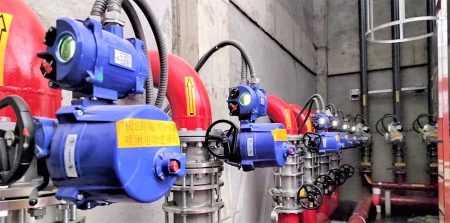
Modulating valves make it easier to keep systems working well. These valves help engineers and technicians fix things faster. They also make repairs take less time and effort. Many modulating valves are built so they are simple to check, clean, and fix.
Key Maintenance Benefits of Modulating Valves:
- Fewer Breakdowns:
Modulating valves move gently and do not stop suddenly. This soft movement puts less stress on the parts. Because of this, the valves last longer and do not break as much. - Easy Access for Repairs:
Many modulating valves are made so workers can reach parts quickly. For example, globe valves have bonnets that come off. This lets workers check or change the seat and plug without taking out the whole valve. - Predictable Wear Patterns:
These valves move in small steps, so seals and seats wear out slowly and evenly. Technicians can plan checks and change parts before anything goes wrong. - Self-Diagnostics:
New modulating valves have smart sensors and digital positioners. These tools watch the valve’s health and send alerts if there is a problem. Maintenance teams can find issues early and fix them before the valve breaks.
Tip: Valves with self-diagnostics help companies stop costly breakdowns and emergency repairs.
Common Maintenance Tasks for Modulating Valves:
| Task | Description | Benefit |
|---|---|---|
| Inspection | Look for leaks, rust, or worn parts | Stops surprise failures |
| Cleaning | Take out dirt or buildup inside the valve | Keeps flow smooth and steady |
| Lubrication | Put grease or oil on moving parts | Lowers friction and wear |
| Seal Replacement | Change old or broken seals | Stops leaks and makes valves last longer |
| Calibration | Adjust sensors and positioners to be correct | Makes sure control is exact |
Modulating vs. On-Off Valves
Key Differences
Modulating valves and on-off valves do not work the same way. A modulating valve can stop anywhere between open and closed. An on-off valve only opens or closes all the way. This difference changes how each valve controls flow.
| Feature | Modulating Valve | On-Off Valve |
|---|---|---|
| Control | Adjusts to any position | Only open or closed |
| Flow Regulation | Precise and variable | All or nothing |
| Feedback | Uses sensors and feedback | No feedback needed |
| Application | Complex systems needing accuracy | Simple shutoff tasks |
| Cost | Higher due to extra parts | Lower, simple design |
| Response Time | Slower, makes small changes | Fast, quick open/close |
A modulating control valve uses actuators and sensors to keep flow steady. On-off valves do not need these extra parts. They are good for stopping or starting flow fast. Modulating valves help keep temperature, pressure, or flow at the right level. On-off valves cannot do this job.
Tip: Think about what your system needs. If you want steady control, pick a modulating valve. If you only need to stop or start flow, use an on-off valve.
When to Use Each
Engineers pick modulating or on-off valves based on the job. Each type works best for certain tasks.
Use a modulating valve when:
- The system needs exact control of flow, pressure, or temperature.
- The process changes often and needs small adjustments.
- The system uses feedback from sensors to keep things steady.
- Energy savings and product quality matter.
Use an on-off valve when:
- The job only needs to start or stop flow.
- The system does not need fine control.
- Fast action is important, like in emergency shutoff.
- The budget is tight and simple parts are best.
Here is a quick checklist:
- Need precise control? ? Choose a modulating valve.
- Need simple open/close? ? Choose an on-off valve.
- Want to save energy and improve quality? ? Use a modulating valve.
- Need fast shutoff for safety? ? Use an on-off valve.
Note: Picking the right valve helps the system work better and last longer.
Selection Tips
Criteria
Picking the right modulating valve helps the system work well. Engineers check many things before they choose a valve. They look at what kind of fluid will go through the valve. They also check the pressure and temperature in the system. The amount of flow the system needs is important too. The valve’s material must match the fluid so it does not rust or break. Some fluids need special linings or seals to stay safe.
Engineers also think about how fast the valve should move. Some jobs need the valve to change quickly. Other jobs need slow, steady moves. The size of the valve matters a lot. If the valve is too big or too small, it will not work right. The type of control signal is important too. Some systems use electric signals. Others use air or digital signals to control the valve.
Tip: Pick a flow characteristic that fits the system’s needs. This could be equal percentage, linear, or quick opening.
Here is a table to help you choose:
| Selection Factor | What to Check |
|---|---|
| Fluid Type | Is it water, gas, steam, or chemical? |
| Pressure/Temperature | Maximum and minimum values |
| Flow Rate | How much fluid must pass through? |
| Valve Material | Must resist corrosion or wear |
| Actuator Type | Pneumatic, electric, or hydraulic |
| Control Signal | 4-20 mA, 0-10 VDC, or digital |
| Flow Characteristic | Equal percentage, linear, or quick |
Installation
Installing the valve the right way keeps it safe and working longer. Installers must follow the maker’s instructions for every step. They make sure the valve is clean and has no dirt inside. The valve must fit the pipe and match the arrow for flow direction. Installers use the right gaskets and tighten the bolts the same amount.
Heavy valves need support brackets to keep them steady. The actuator must line up with the valve stem. After putting the valve in, installers check for leaks. They test the actuator and control signals before starting the system.
Note: Always test the valve with water or air first. This helps find leaks or wiring problems before real fluids are used.
A checklist for putting in a valve:
- Clean the valve and pipes
- Check the flow direction
- Use the right gaskets and bolts
- Support heavy valves
- Line up actuator and valve stem
- Test for leaks and signal response
Maintenance
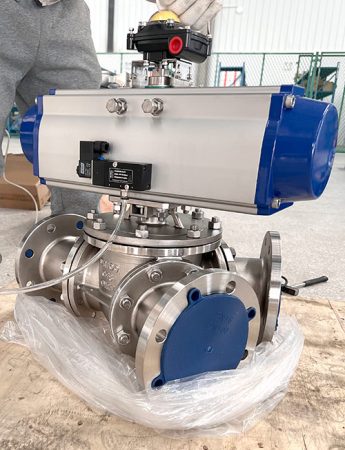
Doing regular maintenance keeps modulating valves working well. Technicians look for leaks, rust, or worn parts on the valve. They clean the valve body and moving parts to stop dirt from building up. Lubrication helps the valve move without sticking. Workers change seals or seats if they look worn out.
Many new valves have sensors that send alerts if something is wrong. Technicians use these alerts to plan repairs before the valve breaks. They also check the actuator and positioner to make sure they move right. Calibration makes sure the valve opens and closes to the right spot.
Tip: Plan maintenance based on how often the valve moves and what fluid it controls. This helps stop sudden breakdowns.
A simple plan for taking care of valves:
- Look for leaks and damage
- Clean and lubricate moving parts
- Change worn seals and seats
- Check actuator and positioner
- Calibrate sensors and controls
Taking care of valves helps them last longer and keeps the whole system safe and working well.
FAQ
What is the main purpose of a modulating valve?
A modulating valve changes how much liquid or gas moves. It does this by opening or closing a little at a time. This helps keep things like temperature and pressure steady. It makes systems safer and helps them work better.
How does a modulating valve differ from an on-off valve?
A modulating valve can stop anywhere between open and closed. An on-off valve only opens all the way or shuts all the way. Modulating valves let you control flow very exactly. On-off valves just start or stop the flow.
Where are modulating valves commonly used?
Engineers put modulating valves in many places. They use them in HVAC, water plants, factories, and oil and gas sites. These valves help with heating, cooling, mixing chemicals, and moving water.
What signals control a modulating valve?
Modulating valves listen to special signals to know what to do. These signals can be electric current, voltage, or air pressure. Control systems send these signals to the valve to change its position.
How often should modulating valves receive maintenance?
Technicians need to check modulating valves often. Most valves should be checked every six months or once a year. Regular checks help stop leaks, wear, and sudden problems.
Can a modulating valve save energy?
Yes, modulating valves help save energy. They only let through as much flow as needed. This means pumps and heaters do not work too hard. Saving energy lowers bills and helps nature.
What types of actuators work with modulating valves?
Modulating valves can use pneumatic, electric, or hydraulic actuators. The best type depends on what the system needs and how much power is there. It also depends on how strong the valve must be.
Are modulating valves hard to install?
Most modulating valves are simple to put in if you follow the instructions. Workers must line up the valve, support it, and check for leaks. Doing these steps helps the valve work safely and last longer.
Tip: Always make sure the valve fits your system before you install it.
